Analysis of the Heat Concentration Phenomenon on the Turbine (TBN) Building of a Coal-Fired Power Plant and Suggestions for Improvement
Abstract
:1. Introduction
2. Analysis of the Heat Concentration Phenomenon on the Turbine (TBN) Floor
2.1. Structure of the Power Plant Turbine (TBN) Building
2.2. Structure of the Turbine (TBN) Floor and Modeling
2.3. Measuring the Temperature of the Main Heat-Generating Parts on the Turbine (TBN) Floor
2.4. Boundary Conditions for the Computational Analysis
2.5. Results of the Heat Concentration Phenomenon on the Turbine (TBN) Floor
3. Analysis of the Heat Concentration Phenomenon on the Mezzanine Floor
3.1. Structure and Shape Modeling of the Mezzanine Floor
3.2. Temperature Measurement of the Main Heat-Emitting Components on the Mezzanine Floor and Boundary Conditions for the Computational Analysis
3.3. Analysis Results of the Heat Concentration Phenomenon on the Mezzanine Floor
4. Results
Author Contributions
Funding
Data Availability Statement
Conflicts of Interest
References
- Cha, K.Y.; Shin, K.Y. Analytic Study on Energy Demand Management State in Industrial Sector. J. Energy Clim. Chang. 2021, 16, 89. [Google Scholar] [CrossRef]
- Um, B.H.; Ahn, C.S. An Economic Analysis of the Effluent Heat Supply from Thermal Power Plant to the Farm Facility House. Korean J. Chem. Eng. 2018, 56, 6. [Google Scholar] [CrossRef]
- Kim, D.H.; Choi, H.S. State of the Art in Life Assessment for High Temperature Components Using Replication Method. J. Korean Soc. Nondestruct. Test. 2010, 30, 489. [Google Scholar]
- Kim, M.J.; Xiao, X.; Lee, D.B. Study of High Temperature Corrosion of Fe-Cr-W Steel in Coal-Biomass Co-firing Power Plant Environment. J. Surf. Sci. Eng. 2019, 52, 251. [Google Scholar] [CrossRef]
- Lee, Y.B. Development of Test Code of MTV & ETV for TPP. J. Drive Control 2011, 8, 28. [Google Scholar] [CrossRef]
- Kim, H.J.; Jeong, Y.G.; Park, J.J. Development of Small-Specimen Creep Tester for Life Assessment of High Temperature Components of Power. Trans. Korean Soc. Mech. Eng. 2000, 24, 2597. [Google Scholar] [CrossRef]
- Bettge, D.; Klinger, C.; Klingbeil, D.; Eberle, A. Investigations on the breakdown of a heat recovery steam generator during the initial operation run. Eng. Fail. Anal. 2014, 43, 253. [Google Scholar] [CrossRef]
- Takahashi, T.; Koda, E.; Nakao, Y. Development of the performance deterioration diagnosis method to thermal power plant. Proc. Int. Conf. Power Eng. 2010, 5, 249. [Google Scholar] [CrossRef]
- Liao, G.S. Analysis of Power Plant Deaerator Under Transient Turbine (TBN) Loads. J. Eng. Gas Turbine (TBN)S Power 1973, 95, 171. [Google Scholar] [CrossRef]
- Kim, J.W.; Jeong, B.Y. Comparison of Occupational Risk Factors and Health-related Problems between Office Workers and Production Workers in the Automobile Manufacturing Industry. Anal. J. Ergon. Soc. Korea 2021, 40, 199. [Google Scholar] [CrossRef]
- Hole, J.A.; Pande, M. Worker productivity, occupational health, safety and environmental issues in thermal power plant. In Proceedings of the IEEE International Conference on Industrial Engineering and Engineering Management 2019, Hong Kong, China, 8–11 December 2009. [Google Scholar] [CrossRef]
- Danquah, R.; Mensah, G.; Senyo, W.; Davis, F. Assessment of hazard recognition performance of thermal power plant workers: A case study of a combined cycle power plant. Cogent Eng. 2023, 310, 50. [Google Scholar] [CrossRef]
- Chen, M.L.; Chen, C.J.; Yeh, W.Y.; Huang, J.W.; Mao, I.F. Heat Stress Evaluation and Worker Fatigue in a Steel Plant. AIHA J. 2003, 64, 352. [Google Scholar] [CrossRef]
- Du, J.; Li, Y.; Zhao, Y.; Da, Y.; Che, D. Numerical Study of Supercritical Opposed Wall-Fired Boiler Furnace Temperature and High-Temperature Heating Surface Stress under Variable Load Operation. Energies 2024, 17, 663. [Google Scholar] [CrossRef]
- Zhang, H.; Jia, J.; Wang, N.; Hu, X.; Tu, S.-T.; Zhou, S.; Wang, Z. Development of On-Line Monitoring Systems for High Temperature Components in Power Plants. Sensors 2013, 13, 15504–15512. [Google Scholar] [CrossRef]
- Guo, X.; Xia, L.; Zhao, G.; Wei, G.; Wang, Y.; Yin, Y.; Guo, J.; Ren, X. Steam Temperature Characteristics in Boiler Water Wall Tubes Based on Furnace CFD and Hydrodynamic Coupling Model. Energies 2022, 15, 4745. [Google Scholar] [CrossRef]
- Wang, H.; Zhai, J. Simulation Analysis of High Radiant Heat Plant Cooling and Endothermic Screen Waste Heat Recovery Performance Based on FLUENT. Energies 2023, 16, 4196. [Google Scholar] [CrossRef]
- Brzezińska, D.; Brzezińska, M. Performance-Based Solutions of Thermal and Smoke Control Ventilation in Industrial Power Plant Buildings. Energies 2022, 15, 7396. [Google Scholar] [CrossRef]
- Yang, Y.; Cai, Y.; Huang, Y.; Liu, Z.; Xu, F. Fuzzy Optimization Research on Thermal Comfort of Atrium Space in Ofice Buildings under the Natural Ventilation Environment. J. Hum. Settl. West China 2022, 37, 119–125. [Google Scholar]
- Occupational Safety and Health Agency. Available online: https://kosha.or.kr/kosha/intro/jeonbukBranch_A.do?mode=download&articleNo=350706&attachNo=197677 (accessed on 10 July 2023).


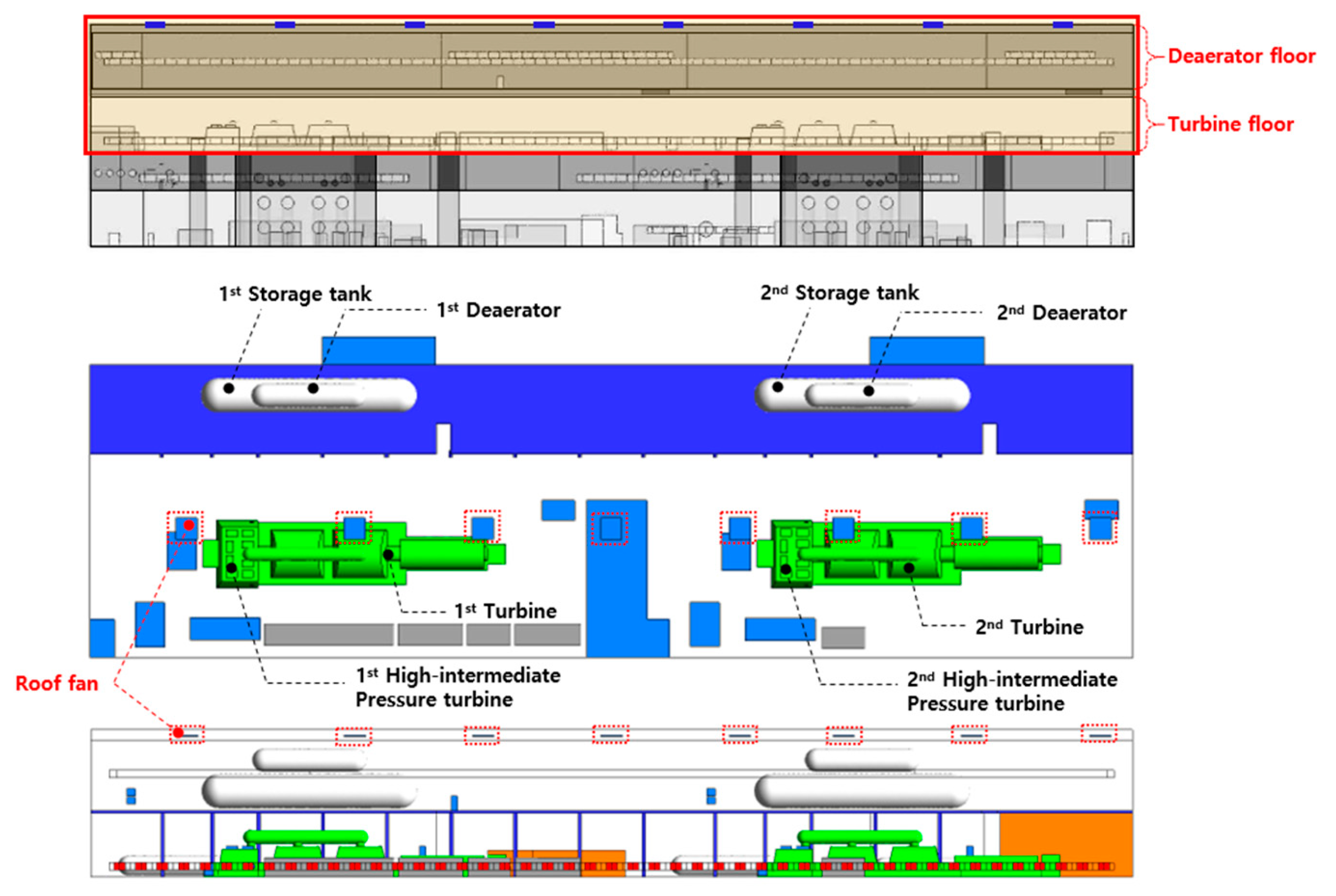


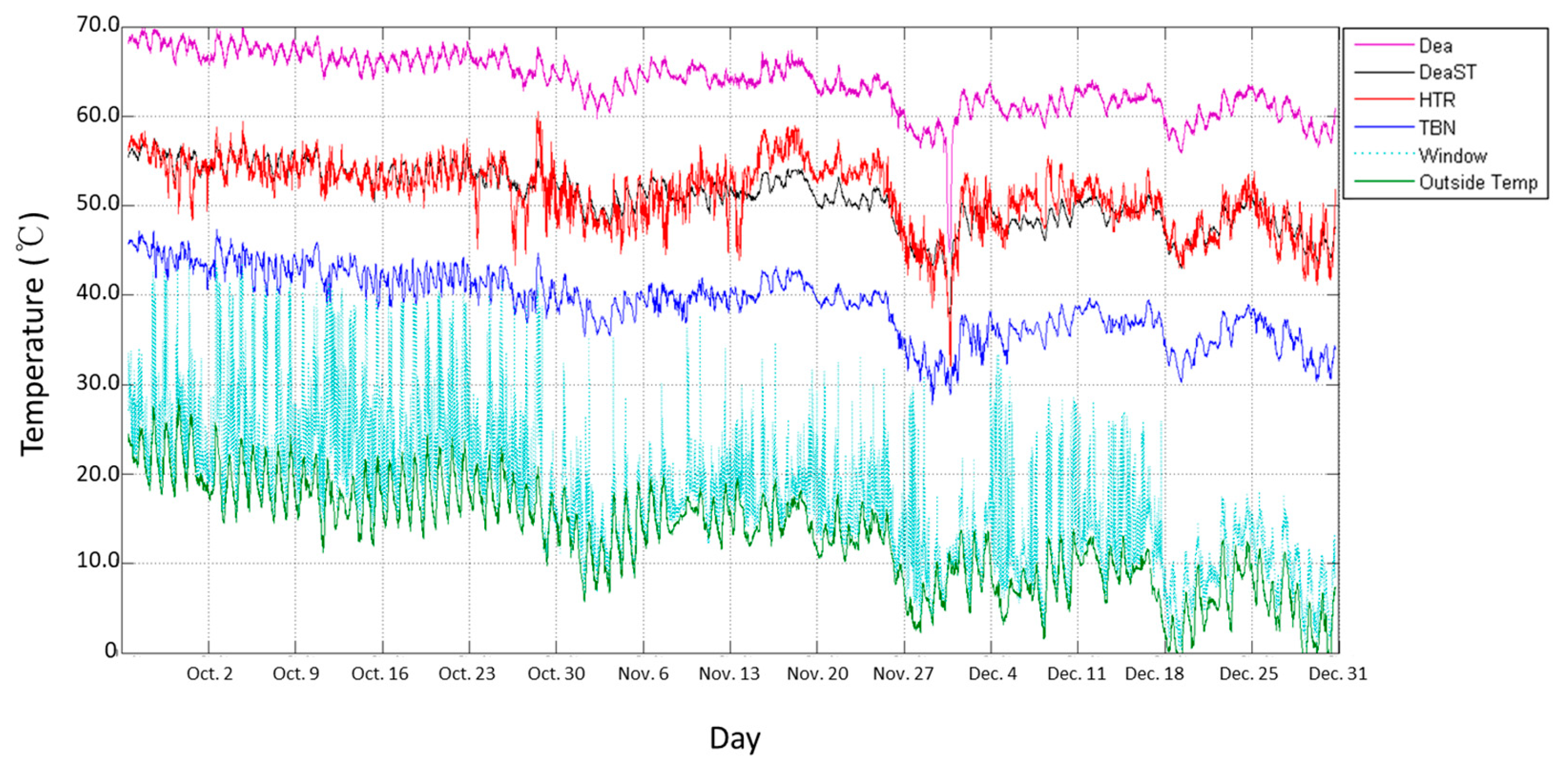

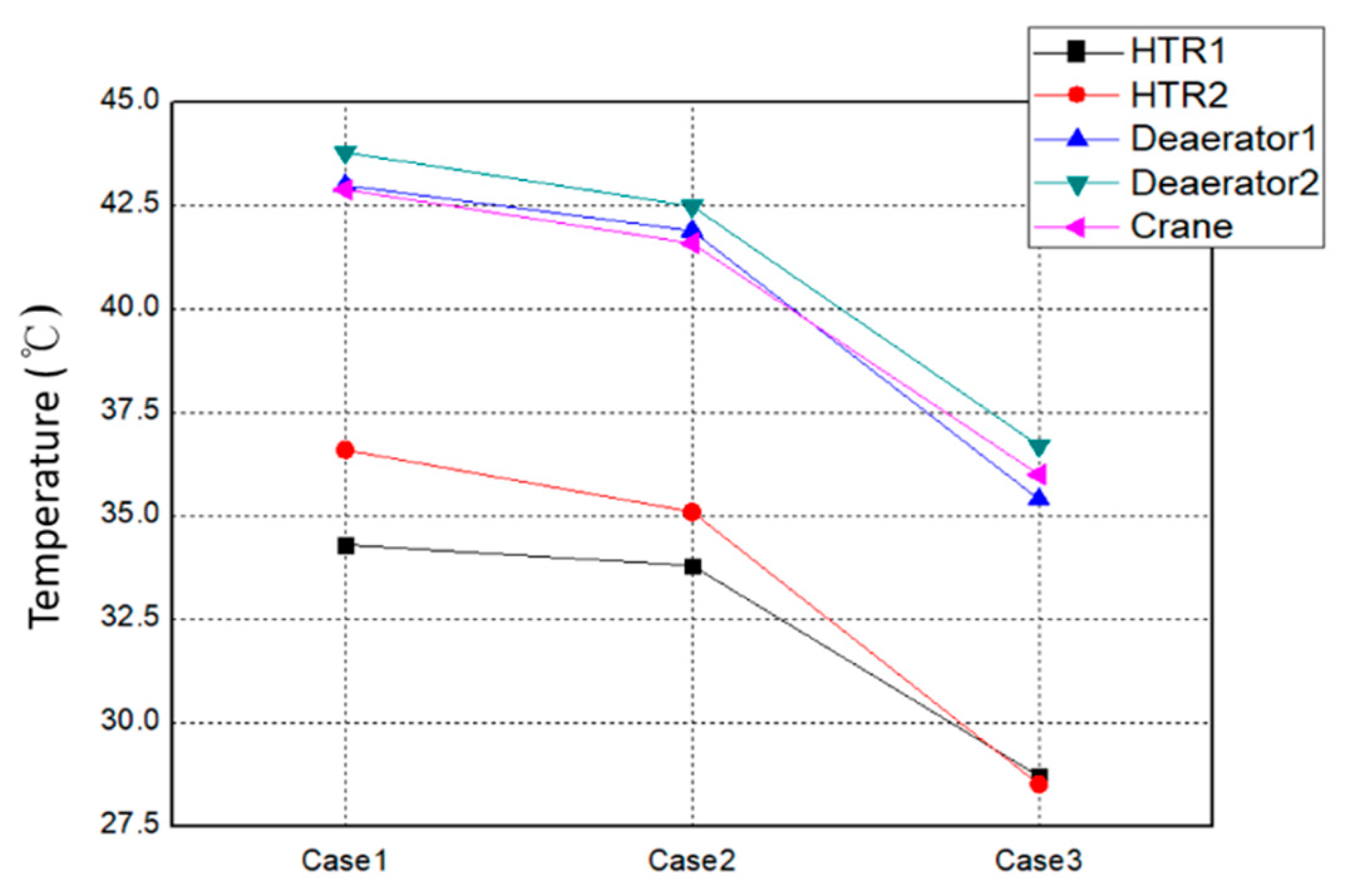

| Division | Ventilation Conditions | Temperature of Heating Parts |
|---|---|---|
| Case1 | Window: half open Roof fan: 2900 m3/min × 8 |
|
| Case2 | Window: full open Roof fan: 2900 m3/min × 8 | |
| Case3 | Window: full open Roof fan: 2900 m3/min × 8 Dea. Fan: 2900 m3/min × 2 |
| Properties | Calcium-Carbonate (CaCO3) | Aluminum (Al) | ||||
|---|---|---|---|---|---|---|
| Density (kg/m3) | 2800 | 2719 | ||||
| Specific heat (J/kgK) | 856 | 871 | ||||
| Thermal conductivity (W/mK) | 2.25 | 202.40 | ||||
| Properties | P = C1T2 + C2T + C3 | |||||
| C1 | C2 | C3 | ||||
| Density (kg/m3) | 2.9082 × 100 | −7.800 × 10−3 | 6.9148 × 10−6 | |||
| Specific heat (J/kgK) | 1.0629 × 103 | −3.9570 × 10−1 | 6.9204 × 10−4 | |||
| Thermal conductivity (W/mK) | −7.8959 × 10−4 | 1.0490 × 10−4 | −5.0803 × 10−8 | |||
| Viscosity (kg/ms) | 1.4801 × 10−6 | 6.6959 × 10−8 | −3.4979 × 10−11 | |||
| Division | Temperature Contour | Volume of High Temperature | |
|---|---|---|---|
 (Unit: °C) | Case1 | 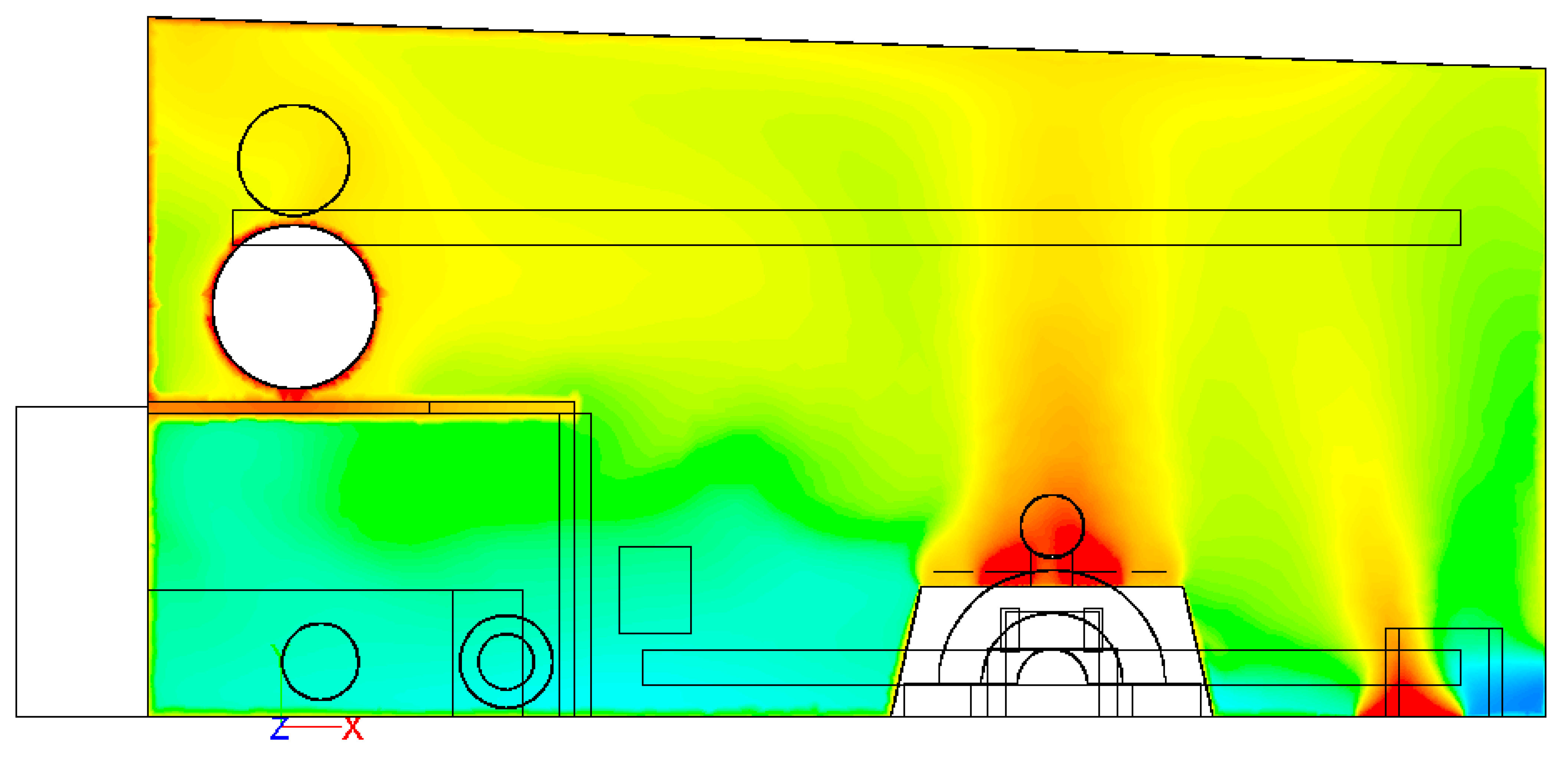 | 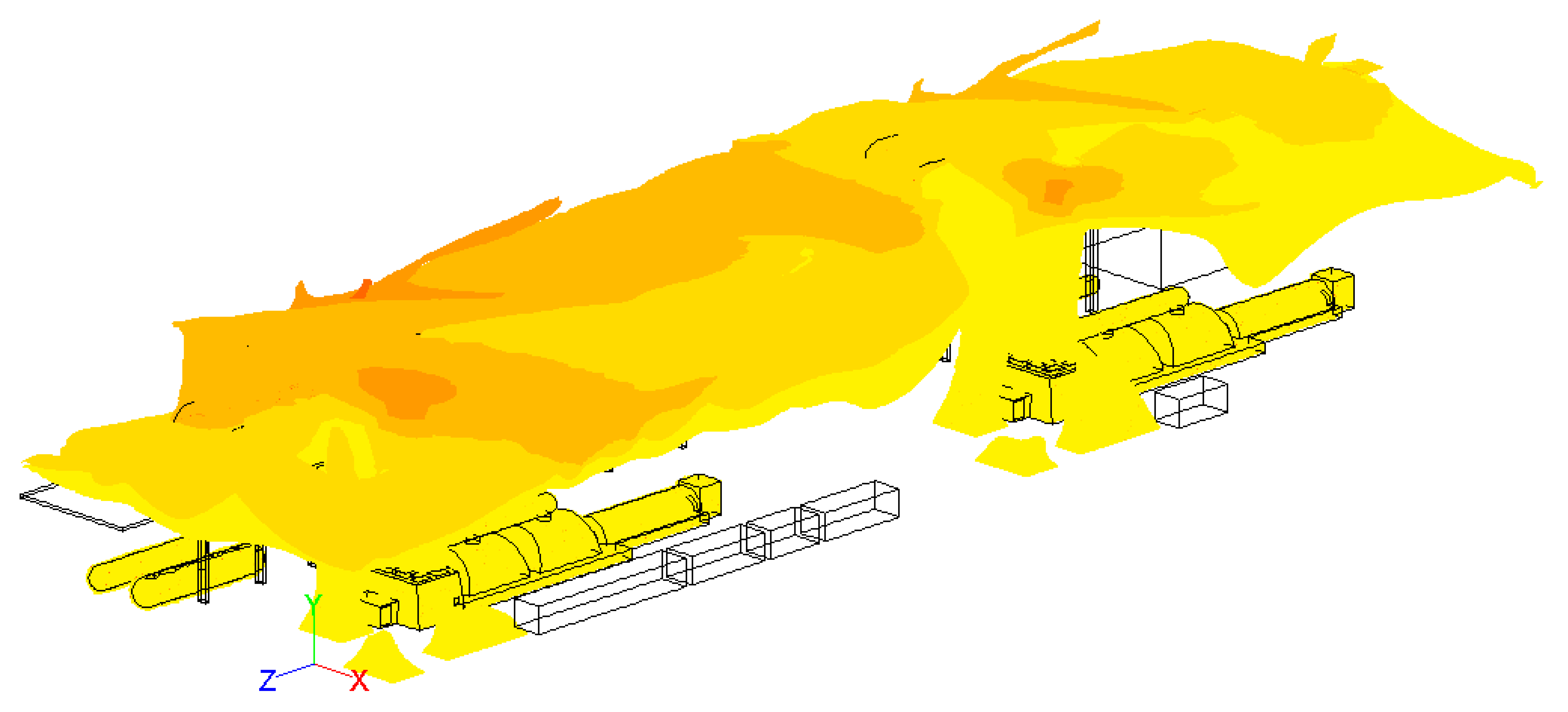 |
| Case2 |  | 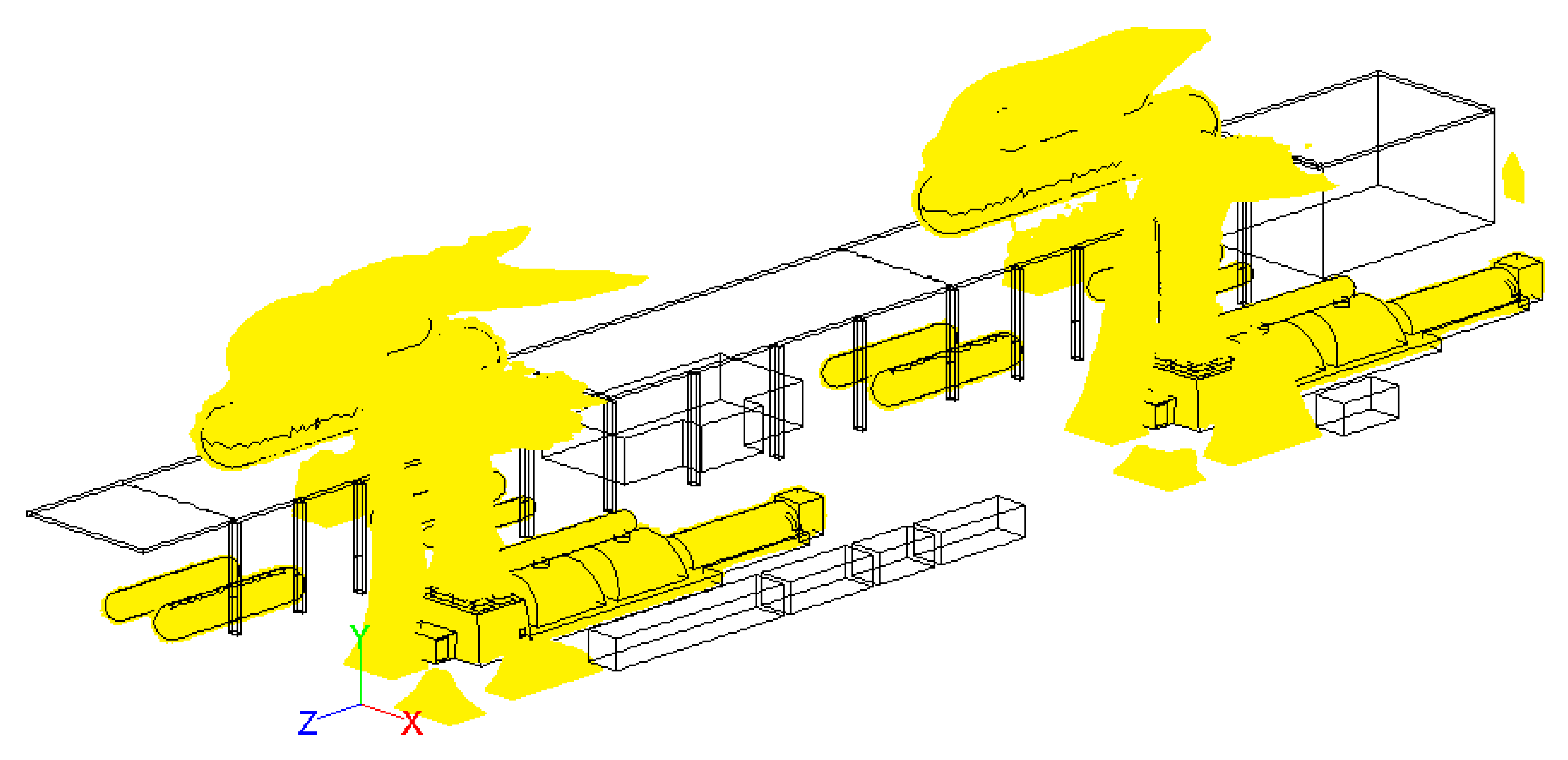 | |
| Case3 | 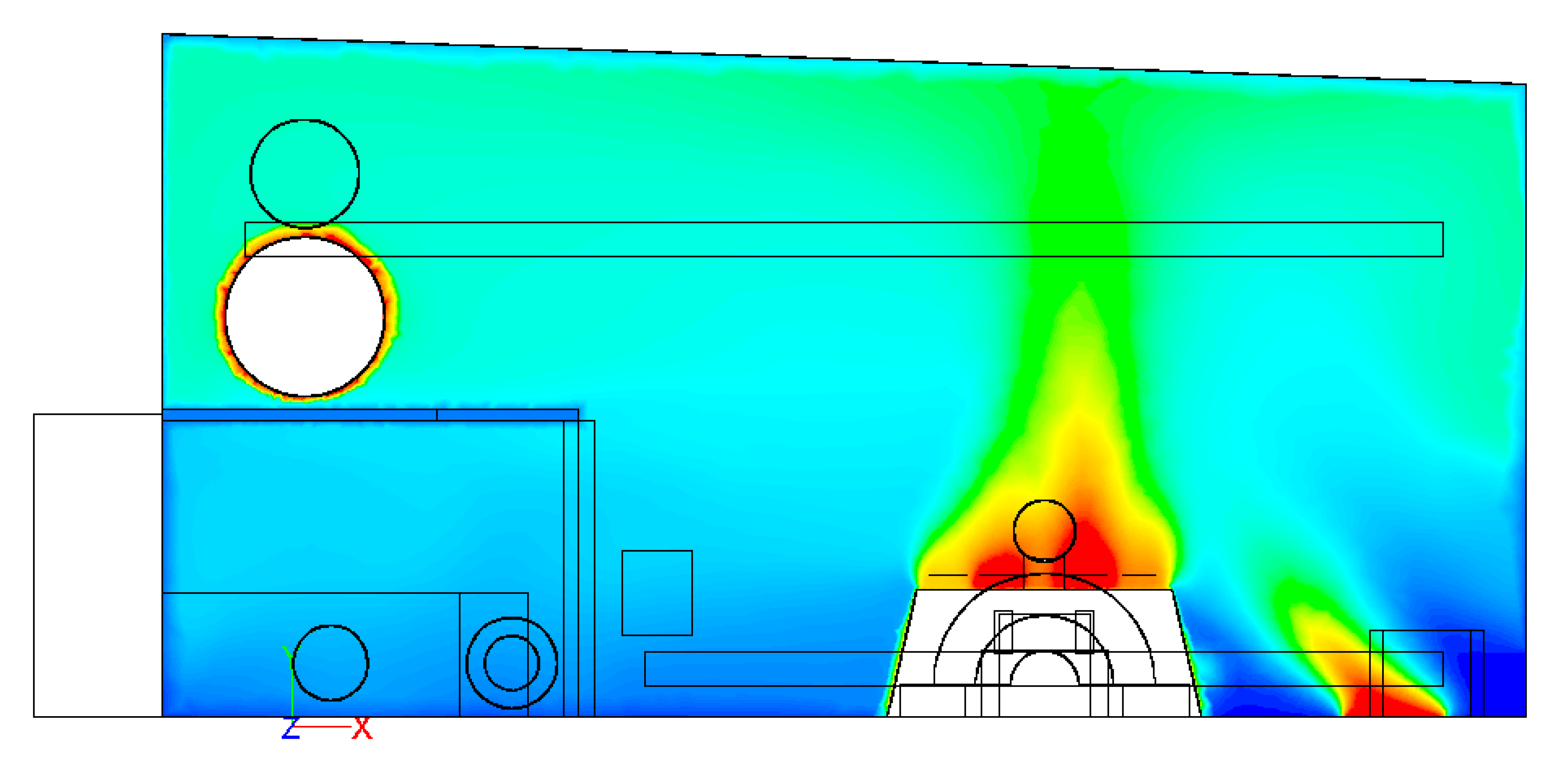 | 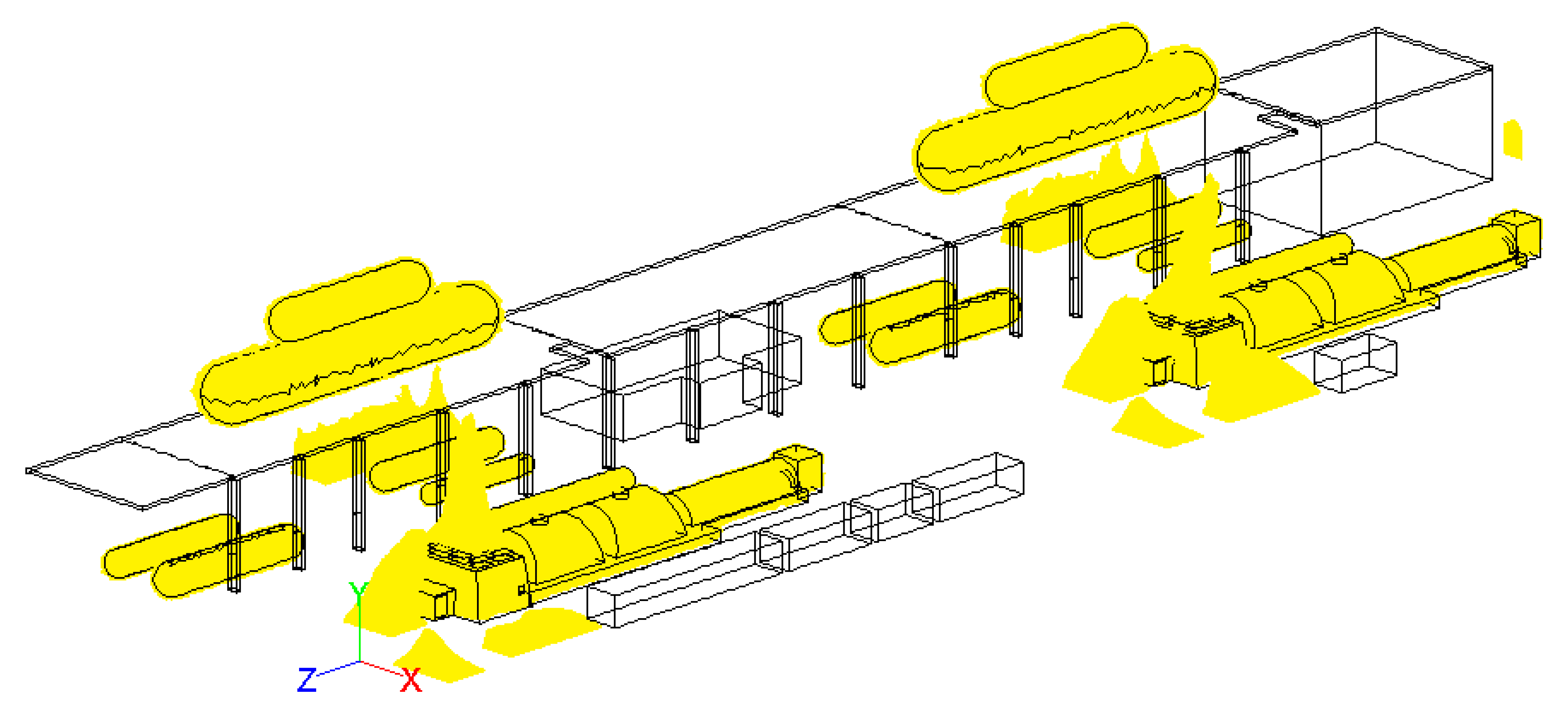 | |
| Parts | Temperature (°C) | |
|---|---|---|
| Summer | Winter | |
| Main stop valve pipe 1 | 110.0 | 100.0 |
| Main stop valve pipe 2 | 80.0 | 70.0 |
| Boiler feed water pump turbine (TBN) | 42.0 | 36.0 |
| Heater 1 | 36.1 | 31.5 |
| Heater 2 | 35.6 | 32.0 |
| Heater 3 | 39.8 | 36.0 |
| Heater 4 | 54.6 | 50.0 |
| High-intermediate pressure turbine (TBN) 1 | 54.6 | 50.0 |
| High-intermediate pressure turbine (TBN) 2 | 63.3 | 60.0 |
| High-intermediate pressure turbine (TBN) 3 | 69.2 | 66.5 |
| High-intermediate pressure turbine (TBN) 4 | 59.0 | 56.3 |
| High-intermediate pressure turbine (TBN) 5 | 64.3 | 62.0 |
| High-intermediate pressure turbine (TBN) 6 | 53.1 | 49.0 |
| Parts | (Unit: m/s) | Summer | Winter |
|---|---|---|---|
| 5th high-intermediate pressure turbine (TBN) |  |  |  |
| 5th main stop valve |  |  | |
| 6th high-intermediate pressure turbine (TBN) |  |  | |
| 6th main stop valve |  |  |
| Parts | (Unit: °C) | Summer | Winter |
|---|---|---|---|
| 5th HIP |  |  |  |
| 5th MSV |  |  | |
| 6th HIP |  |  | |
| 6th MSV |  |  |
| Parts | (Unit: °C) | Summer | Winter |
|---|---|---|---|
| 5th HIP |  |  |  |
| 5th MSV |  |  | |
| 6th HIP |  |  | |
| 6th MSV |  |  |
| Summer | Winter | |||||||
|---|---|---|---|---|---|---|---|---|
| Static Temp. | Radiation Temp. | Static Temp. | Radiation Temp. | |||||
| 5 | 6 | 5 | 6 | 5 | 6 | 5 | 6 | |
| High-intermediate pressure turbine (TBN) | 29.0 | 29.2 | 50.8 | 51.4 | 22.5 | 22.8 | 42.9 | 43.3 |
| Main stop valve | 29.1 | 29.4 | 46.5 | 47.2 | 22.5 | 22.7 | 46.7 | 39.3 |
Disclaimer/Publisher’s Note: The statements, opinions and data contained in all publications are solely those of the individual author(s) and contributor(s) and not of MDPI and/or the editor(s). MDPI and/or the editor(s) disclaim responsibility for any injury to people or property resulting from any ideas, methods, instructions or products referred to in the content. |
© 2024 by the authors. Licensee MDPI, Basel, Switzerland. This article is an open access article distributed under the terms and conditions of the Creative Commons Attribution (CC BY) license (https://creativecommons.org/licenses/by/4.0/).
Share and Cite
Cho, M.-L.; Lee, S.-B. Analysis of the Heat Concentration Phenomenon on the Turbine (TBN) Building of a Coal-Fired Power Plant and Suggestions for Improvement. Fluids 2024, 9, 145. https://doi.org/10.3390/fluids9060145
Cho M-L, Lee S-B. Analysis of the Heat Concentration Phenomenon on the Turbine (TBN) Building of a Coal-Fired Power Plant and Suggestions for Improvement. Fluids. 2024; 9(6):145. https://doi.org/10.3390/fluids9060145
Chicago/Turabian StyleCho, Mok-Lyang, and Seon-Bong Lee. 2024. "Analysis of the Heat Concentration Phenomenon on the Turbine (TBN) Building of a Coal-Fired Power Plant and Suggestions for Improvement" Fluids 9, no. 6: 145. https://doi.org/10.3390/fluids9060145






